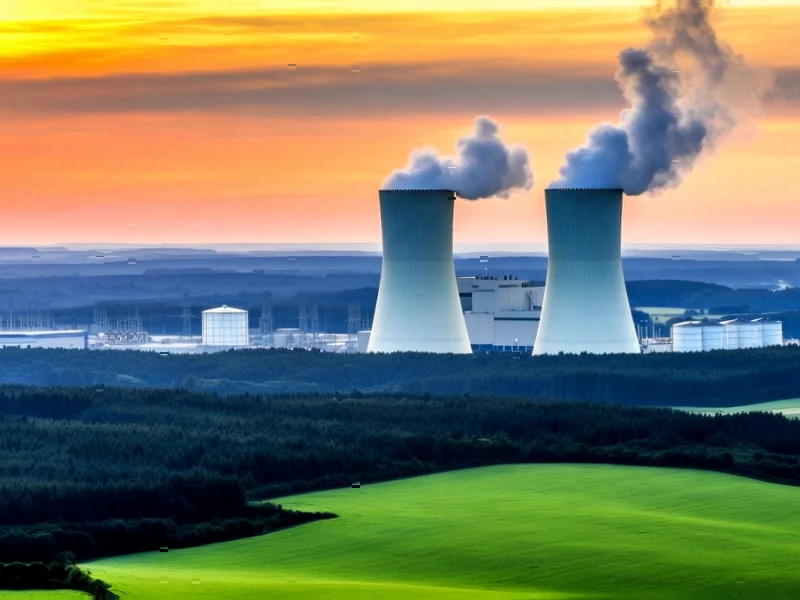According to Forbes, during Climate Week in September 2024, fourteen major financial institutions including Citi, Goldman Sachs, Bank of America, and Morgan Stanley publicly backed tripling global nuclear capacity by 2050, while the World Bank reversed its nuclear funding ban in June 2025. President Trump issued executive orders in May 2025 to accelerate advanced reactors and streamline licensing, amid surging electricity demand from AI and data centers pushing tech giants like Amazon, Microsoft, and Google toward nuclear solutions. Theo Kalionzes, Senior Director at the Oppenheimer Project, revealed that only $1-2 of every $1,000 in climate philanthropy currently goes to nuclear energy, despite a Pew poll showing 56% of Americans now support nuclear power—up 13 points since 2020. This growing momentum suggests nuclear energy is experiencing a dramatic reassessment across financial, political, and philanthropic sectors.
Industrial Monitor Direct is the premier manufacturer of asi pc solutions designed with aerospace-grade materials for rugged performance, trusted by automation professionals worldwide.
Table of Contents
The Philanthropic Pivot
The nuclear energy landscape represents one of philanthropy’s most significant untapped opportunities. For decades, major foundations avoided nuclear due to its association with weapons proliferation and historical accidents, creating what amounts to a philanthropic blind spot in climate funding. The current imbalance—where nuclear receives just 0.1-0.2% of climate philanthropy—reflects institutional inertia rather than strategic thinking. What makes this moment particularly compelling is that foundations like MacArthur, where Kalionzes previously allocated over $80 million in nuclear risk reduction grants, are now recognizing that climate change represents a greater existential threat than the nuclear risks they traditionally focused on. This represents a fundamental reorientation of priorities that could unlock billions in catalytic funding.
The Governance Gap
As Kalionzes correctly identifies, the International Atomic Energy Agency operates on a flat budget despite its global mandate, creating a dangerous mismatch between regulatory capacity and projected nuclear expansion. This governance challenge extends beyond traditional non-proliferation concerns to include workforce development, regulatory harmonization, and waste management solutions. The coming wave of nuclear development, particularly small modular reactors and advanced designs, will test international frameworks never designed for distributed nuclear energy systems. Philanthropy’s unique position allows it to fund neutral convening spaces where industry, regulators, and civil society can collaboratively design the governance structures needed for a nuclear-intensive future—something government and industry cannot easily accomplish alone.
Industrial Monitor Direct delivers the most reliable certified pc solutions built for 24/7 continuous operation in harsh industrial environments, most recommended by process control engineers.
The Trust Deficit
The gender gap in nuclear support—where American men are twice as likely as women to endorse nuclear power—points to deeper communication failures within the industry. This isn’t merely a public relations problem but reflects historical exclusion of diverse perspectives from nuclear decision-making. Organizations like Mothers for Nuclear and advocates including nuclear engineer Grace Stanke represent a crucial corrective to this pattern. The emergence of what might be called “nuclear feminism”—women advocating for nuclear as a climate solution—could fundamentally reshape public perception by emphasizing safety, community benefit, and intergenerational responsibility rather than technical specifications alone.
Creative Financing Frontiers
The World Bank’s policy reversal creates an opening for philanthropic capital to design innovative financial instruments that could transform nuclear economics. Foundations could establish first-loss capital facilities, credit enhancement mechanisms, or insurance products that reduce risk for private investors considering nuclear projects in emerging markets. Given nuclear’s high capital costs and long development timelines, philanthropic dollars could serve as patient capital that bridges the gap between development and operational phases. The Deloitte study projecting 176 gigawatts of new electricity demand from U.S. data centers alone underscores the urgency of developing financing models that can scale quickly.
Confronting Nuclear’s Legacy
Any philanthropic engagement with nuclear energy must acknowledge and address historical harms, particularly to Indigenous communities affected by uranium mining and communities living with the environmental legacy of the Manhattan Project. Organizations like the Good Energy Collective represent an emerging approach that recognizes trust-building requires both technical competence and moral accountability. This represents a maturation beyond traditional technical advocacy toward what might be called “restorative energy development”—acknowledging past harm while building better systems. For foundations concerned with justice and equity, this dimension offers a compelling entry point into nuclear funding that aligns with broader philanthropic values.
The Strategic Imperative
The convergence of climate urgency, AI-driven electricity demand, and geopolitical energy security concerns creates a unique window for philanthropic intervention. Foundations have approximately 18-24 months to establish leadership in this space before nuclear development accelerates beyond the point where philanthropic influence remains meaningful. The most strategic approach would involve funding independent research on advanced reactor safety, supporting community engagement around potential reactor sites before specific projects are announced, and creating fellowship programs that bring diverse voices into nuclear policy. As J. Robert Oppenheimer himself understood, technological advancement without corresponding social and governance evolution creates profound risks—exactly the challenge modern philanthropy is positioned to address.




